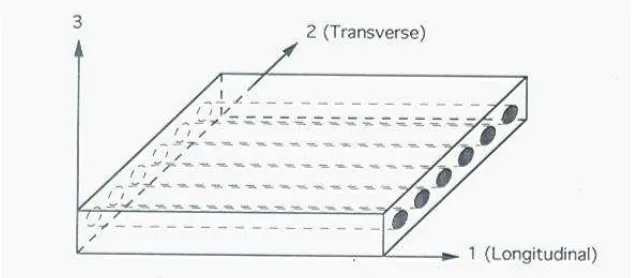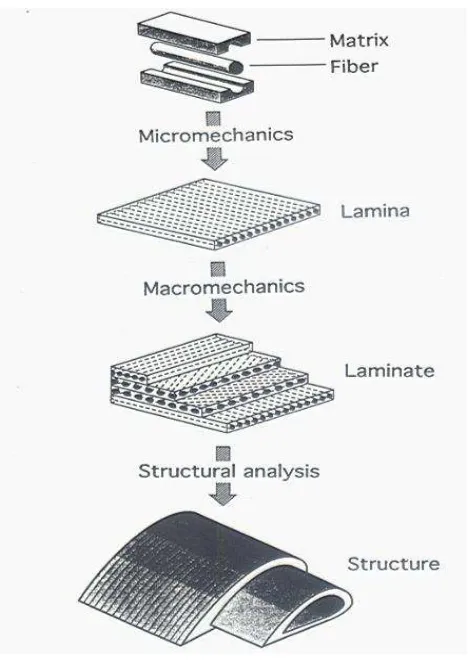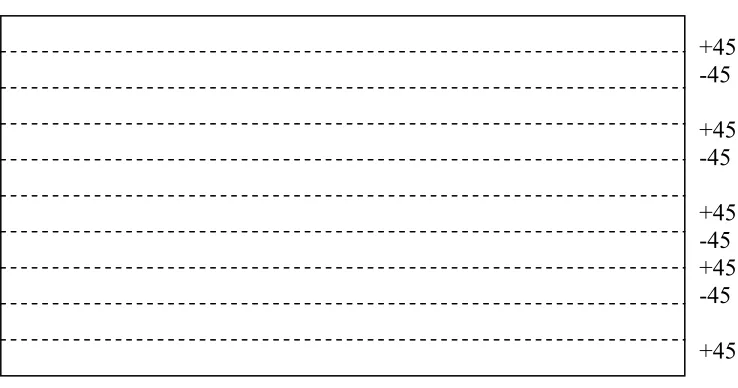QUASI-STATIC INDENTATION FORCE ON COMPOSITE MATERIAL
SYED HAMZAH BIN SYED OTHMAN
This report was submitted in accordance with the partial requirements for the honor of Bachelor of Mechanical Engineering (Structure & Material)
Faculty of Mechanical Engineering Universiti Teknikal Malaysia Melaka
ii
“I verify that this report is my own word except summary and extract that every one of it I have clarify the resource”
Signature : ………
Author’s Name : Syed Hamzah Bin Syed othman
iii
DEDICATION
To My Beloved Family,
To My Respectful Supervisor,
To My Honorable Lecturers,
iv
ACKNOWLEDGEMENT
Greatest thanks to ALLAH Almighty for giving me the guidance to do the research on this topic, give ideas on solving the problems that occur, and helping me in the ability for me to complete this project that was given to me. I hope with this knowledge that I get, it will help the next generation to know more information about this topic.
For my respectful supervisor which is also my lecturer, Mr. Ahmad Rivai, who has given his full support in giving guidance on how to do this project, ideas and also advice for the mistake that I have done in order to improve myself, I would like to express my highest appreciation for guiding me in this project.
A deepest thanks for all the lecturers and technicians in the Faculty of Mechanical Engineering at Universiti Teknikal Malaysia Melaka (UTeM) for their supports and guidance during my work in collecting the data and other information that is useful for my project. I would also like to express my gratitude to my beloved family and my fellow friends for their support from the back for me in order to fulfill this project completion.
v
ABSTRAK
vi
ABSTRACT
vii
TABLE OF CONTENTS
CHAPTER TOPIC PAGE
CONFESSION ii
DEDICATION iii
ACKNOWLEDGEMENT iv
ABSTRAK v
ABSTRACT vi
TABLE OF CONTENTS vii
LIST OF TABLES x
LIST OF FIGURES xi
LIST OF SYMBOLS xiii
LIST OF APPENDIX xiv
CHAPTER I INTRODUCTION 1
1.1 Background of Study 1
1.2 Objectives 1
1.3 Scope 2
viii
CHAPTER TOPIC PAGE
CHAPTER II LITERATURE REVIEW 4
2.1 Composite Materials 4
2.1.1 Lamina and Laminate 5
2.2 Quasi-Static Indentation Force Test 8
2.3 Non-Destructive Testing 9
2.3.1 Ultrasonic Techniques 9
2.3.1.1 Three Modes of Images
Presentation 10
2.3.1.2 Acoustic Backscattering
Technique 12
2.4 ASTM (American Standard for Testing
and Materials) 14
2.4.1 Scope 14
2.4.2 Summary of Test Method 15
CHAPTER III METHODOLOGY 16
3.1 Methodology Planning 16
3.2 Project Workflow 17
3.3 Material Selection 18
3.4 Design of Experiment 20
3.4.1 Quasi-Static Indentation Force Test 21
3.4.2 Ultrasonic Testing 24
CHAPTER IV RESULTS 26
4.1 Quasi-Static Indentation Force Test 26
ix
CHAPTER TOPIC PAGE
CHAPTER V DISCUSSION 36
5.1 Quasi-Static Indentation Force Test 36
5.2 Ultrasonic Test 37
CHAPTER VI CONCLUSION 39
6.1 Conclusion 39
6.2 Recommendation 39
REFERENCES 41
BIBLIOGRAPHY 42
x
LIST OF TABLES
NO. TITLE PAGE
3.1 Experimental data 24
xi
LIST OF FIGURES
NO. TITLE PAGE
2.1 Unidirectional lamina and principal coordinates axes 5 (Source: Daniel I M and Ishai O,1994)
2.2 Multidirectional laminate and reference coordinate system 6 (Source: Daniel I M and Ishai O,1994)
2.3 Levels of observation and types of analysis for composite materials 7 (Source: Daniel I M and Ishai O,1994)
2.4 [±45]ns angle-ply laminte 7
2.5 Layer Orientation of the Specimen 8
2.6 Comparison of ultrasonic scanning techniques: (a) A specimen containing a delamination; (b) A-scan wave; (c) B-scan view; (d)
planar view of the C-scan. 11
(Source: McIntire P, 1991)
2.7 Acoustic backscattering C-scan image of an IM7G/3501-6 carbon
fibre-epoxy matrix composite 14
(Source: Cawley P and Adams R D,1989)
3.1 Project Workflow and Methodology 17
3.2 Material Specifications 19
3.3 Material Specifications 20
3.4 Quasi-Static Indentation Force Test 21
3.5 Typical F/δ Response for the Simply Supported Configuration 23 (Source: ASTM D 6264 – 98)
xii
NO. TITLE PAGE
4.0 (a) UTM Instron ; (b) Quasi-static Indentation Force Test 27 4.1(a) Graph of Quasi-static Indentation Force Test for Specimen 1 27 4.1(b) Graph of Quasi-static Indentation Force Test for Specimen 2 28 4.1(c) Graph of Quasi-static Indentation Force Test for Specimen 3 29 4.1(d) Graph of Quasi-static Indentation Force Test for Specimen 4 29 4.1(e) Graph of Quasi-static Indentation Force Test for Specimen 5 30 4.1(f) Graph of Quasi-static Indentation Force Test for Specimen 6 31
4.2 Defect area on the plate 33
xiii
LIST OF SYMBOLS
MHz = frequency, MegaHertz d = compressive extension, mm
F = minimum load, kN
Fmax = maximum force, kN δ = indenter displacement, mm K.E. = Kinetic Energy, Joule
v = Velocity, mm/min
U = Energy, Joule
NDT = Non-Destructive Testing UT = Ultrasonic testing UTM = Universal Testing Machine
xiv
LIST OF APPENDIX
NO. TITLE PAGE
A Mould Preparation 43
B Mould Preparation 44
C Material Specification 45
D Material Specification 46
E Material Specification 47
F Material Specification 48
G Material Specification 49
H Material Specification 50
I Material Specification 51
J Material Specification 52
K Material Specification 53
1
CHAPTER I
INTRODUCTION
1.1 Background of Study
In recent years, advanced fiber reinforced composites have gradually emerged as
a new class of engineering materials and have been gaining increasing acceptance in the
engineering design of structural components. The desirable properties of high strength to
weight and stiffness to weight ratios, together with the good fatigue resistance of
composites to cyclic loading, have made strong candidate materials for many structural
applications including aircraft, spacecraft and automobiles. The resulting demand for
new design and methodology have prompted an increasing interest for better
understanding of the response of the material under various kinds of loading and service
conditions.
1.2 Objectives
This thesis is done to study the minimum energy required to start the crack
initiation and to check whether the crack have occur in the impacted plate of composite
2
1.3 Scope
A test of quasi-static indentation force on composite material will be design. An
experiment will be conducted using quasi-static indentation method base on the ASTM
to determine the effect of the indentation force on the composite materials. A
Non-Destructive Test (NDT) will be carried out to study the cracks that occur due to the
quasi-static indentation force test.
Execute of the quasi-static indentation force test and the non-destructive test. The
data that will be collected from the quasi-static indentation force test are the loads value
that will be applied, the delamination value and the crack growth initiation on the
composite plate. The data that would be get from the NDT is the existence of cracks.
Analysis will be carried out on the experimental results. All the results data will
be compared and summarized to make a conclusion for this study.
1.4 Problem Statement
The inspection and maintenance of the composite materials that has been widely
used by the transportation industry is a major challenge for the manufacturers. All the
components that are being used will surely suffer a consecutive impact from many
aspects. It has become essential for these composite structures to perform well under
various types of impact loading. For example, in the aerospace industry, the residual
compressive strength of an impact-damaged composite structure has become the
design-limiting factor.
In this project, the most suitable experiment has to be conducted due to the topic
that’s being proposed. A new design of experiment for the material that will be tested
3
have to be validated, and can be prepared by the university. The way of the experiment
that should be executed must be prepared and referred to the American Society for
Testing and Materials (ASTM) for the safety reason and to obtain the right data from the
4
CHAPTER II
LITERATURE REVIEW
2.1 Composite Materials
A structural composite is a material system consisting of two or more phases on
a macroscopic scale, whose mechanical performance and properties are designed to be
superior to those of the consistent materials acting independently. One of those phase is
usually discontinuities, stiffer, and stronger and is called reinforcement, whereas the less
stiff and weaker phase is continuous and is called matrix. Sometimes, because of
chemical interactions or other processing effects, an additional phase, called interphase,
exists between the reinforcement and the matrix. The properties of a composite material
depend on the properties of the constituents, geometry, and distribution of the phases.
One of the most important parameters is the volume fraction of reinforcement, or fiber
volume ratio. The distribution of the reinforcement determines the homogeneity or
uniformity of the material system. The more the non-uniform is the reinforcement
distribution, the more heterogeneous is the material and the higher is the probability of
failure in weakest areas. The geometry and orientation of the reinforcement affect the
anisotropy of the system.
The phases of composite system have different roles that depend on the type and
5
composite materials, the reinforcement, usually in the form of short fibers particles,
provides some stiffening but only local strengthening of the material. The matrix, on the
other hand, is the main load-bearing constituent governing the mechanical properties of
the material. In the case of high performances structural composites, the usually
continuous-fiber reinforcement is the backbone of the material that determines its
stiffness and strength in the direction of fibers. The matrix phase provides protection and
support for the sensitive fibers and local stress transfer from one fiber to another. The
interphase, although small in size, can play an important role in controlling the failure
mechanisms, fracture toughness, and overall stress-strain behavior of the material.
2.1.1 Lamina and Laminate
A plane layer of unidirectional fibers or woven fabric in a matrix is called
lamina. It is also referred to as unidirectional lamina in the case of unidirectional fibers.
The lamina is an orthotropic material with principal material axes in the direction of
fibers (longitudinal), normal to the fibers in the plane of the lamina (in-plane transverse),
and normal to the plane of the lamina (Figure 2.1). In the case of a woven fabric
composite, the warp and the fill directions are the in-plane principal directions.
Figure 2.1 Unidirectional lamina and principal coordinates axes.
6
A laminate is made up of two or more unidirectional laminate or plies stacked
together at various orientations (Figure 2.2). The laminate (or plies, or layers) can be of
various thicknesses and consist of different materials. Since the principal material axes
differ from the ply to ply, it is more convenient to analyze laminates using a common
fixed system of coordinates (x,y,z) as shown. The orientation of a given ply is given by
the angle between the reference x-axis and the major principal material axis (fiber
orientation) of the ply, measured in a counterclockwise direction on the x-y plane.
Figure 2.2 Multidirectional laminate and reference coordinate system.
(Source: Daniel, (1994)
Composite laminate structure containing plies of two or more different type of
materials are called hybrid composites and, more specifically, interplay hybrid
composites. For example, a composite laminate may be made up of unidirectional glass/epoxy, carbon/epoxy and aramid/epoxy layers stacked together in a specified
sequence. In some cases it may be advantageous to intermingle different types of fibers,
such as glass and carbon or aramid and carbon, within the same unidirectional ply. Such
composites are called intraply hybrid composites. Of course, one could combine
intraply hybrid layers with other layers to form an intraply-interply composite.
Composite laminates are designated in a manner indicating the number, type,
orientation, and stacking sequence of the plies. The configuration of the laminate
7
to the ply composition, the exact location or sequence of the various plies is called the
stacking sequence.
Figure 2.3 Levels of observation and types of analysis for composite
materials
(Source: Daniel, (1994))
8 +45 -45 +45 -45 +45 -45 +45 -45 +45
Figure 2.5 Layer Orientation of the Specimen
2.2 Quasi-Static Indentation Force Test
A quasi-static process is a process that happens infinitely slowly. In practice,
such processes can be approximated by performing them "very slowly". A quasi-static
process often ensures that the system will go through a sequence of states that are
infinitesimally close to equilibrium, in which case the process is typically reversible.
There were three reasons of conducting quasi-static indentation force tests.
Firstly, it was easier to develop some preliminary understanding of damaged
characteristics by executing a quasi-static test in a much better controlled manner. This
knowledge of what to expect allowed the impact tests to be carried out more effectively.
Secondly, the quasi-static results could be treated as very low velocity impacts when
examining the effect of impact velocity on damage at a later stage. Thirdly, it made it
possible to examine the interaction of local indentation and global plate deflection and
9
2.3 Non-Destructive Testing
Non-Destructive Testing (NDT) is the use of special equipment and methods to
learn something about an object without harming the object. NDT also is a test methods
used to examine an object, material or system without impairing its future usefulness.
NDT method can detect and assess the inhomogeneities and harmful defects without
impairing the usefulness of materials/components/systems (test object). There are six
basic of NDT method which are Visual Inspection, Penetrant Testing, Magnetic Particle
Inspection, Eddy Current Testing, Ultrasonic Testing and Radiography.
2.3.1 Ultrasonic Techniques
Ultrasonic measurements are commonly used to detect damage in composite
structures. The basic principles of all these techniques is that ultrasonic pulse (usually in
the frequency range from 1 to 20 MHz) are generated and transmitted through the
material to a transducer or are reflected back to the input transducer by defects or
materials inhomogeneities (reflection or pulse-echo mode) (McIntire P, 1991) [6]. In
both techniques, a piezoelectric transducer is placed on one surface of the specimen to
introduce sound waves in the ultrasonic frequency range. In general, a frequency of 10
MHz or higher is used for thin laminates while the frequency can be as slow as 2 MHz
for thick laminates. As the sound waves propagate through the material, some of them
are interrupted by the presence of defects or materials inhomogeneities, and the energy
levels are attenuated. Some of these attenuated waves propagate though the specimen,
while other waves are reflected back to the surface. The amplitude, frequency
dependence and arrival times of detected pulse are used for defect analysis. Careful
examination of the dependence of ultrasonic attenuation on frequency allows materials



